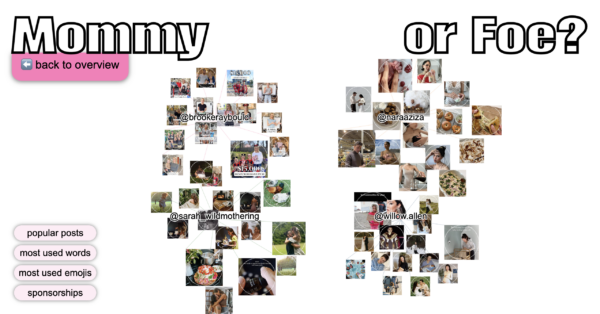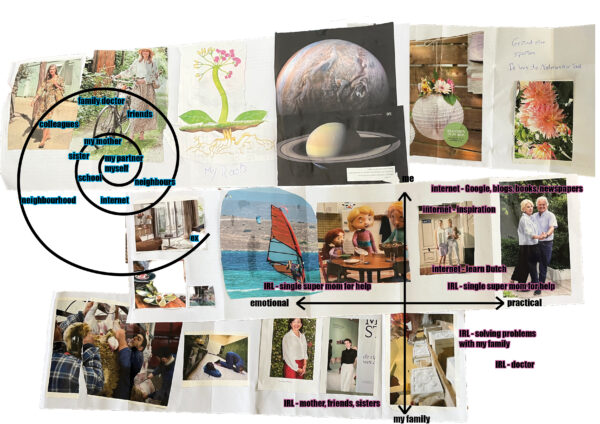For this dossier, The Hmm took on its role of digital anthropologist, hybridly mapping the phenomenon of Momfluencers. We took this on through digital research and a physical community map we made during a workshop with women and mothers from the Vrouw aan het IJ network.
Digital Map
In 2024, we celebrate the 20th anniversary of online influencing, thanks to the mommy blogger, pioneer of many ways in which we publish our lives online. Mommy bloggers were the precursors of what we now call influencers or content creators. They were the first to publish their everyday lives in text, with tips and advice for fellow parents, and the first to monetise this (with banner ads, for example). As social media transitioned from individual blogs to profile pages, the Internet became more about imagery and less about writing, more about immediacy and on-the-go content, and less about sitting down to read. That’s when mommyblogging transformed into momfluencing.
Today, the momfluencing phenomenon is filled with different sub-niches and sub-cultures, with the most algorithimically visibilized of them falling in an overarching imaginary of clean, beige, and marble-floored houses, making sourdough pastries from scratch, vegetable gardens, impeccable bodies and clothes, providing tips and tricks interspersed with ads and sponsorships. As part of our Mapping Momfluencers dossier, we wanted to map1 out the different narratives that surround, and–more importantly–are shaped by momfluencers. How do momfluencers perform motherhood across different niches of the internet? What does their content say about momfluencers’ core messages? Although this map is not a comprehensive picture of all the momfluencing out there, we have extracted some of the most well known and loved niches and dissect their visual and textual elements, reflecting on how our feeds affect our understanding of online public figures, and how these people affect our feeds.

Here, you can explore the map and read about our findings.
1 Peeters, S., & Hagen, S. (2022). The 4CAT Capture and Analysis Toolkit: A Modular Tool for Transparent and Traceable Social Media Research. Computational Communication Research, 4(2), 571–589. Retrieved from https://computationalcommunication.org/ccr/article/view/120.
Community Map
In the same day as our event on Momfluencers, we spent the morning at Vrouw aan het IJ in Amsterdam Noord, where we gathered with some women of the organisation’s network. We were also joined by Single Super Mom and GGD Amsterdam, who answered women’s questions and shared their experiences of working closely with and around motherhood. For the Community Mapping, we wanted to speak specifically about support networks and how momfluencing started as such a space. We talked about our experiences online, and afterward, mapped out our own networks of support and future wishes for how they can grow and evolve.
